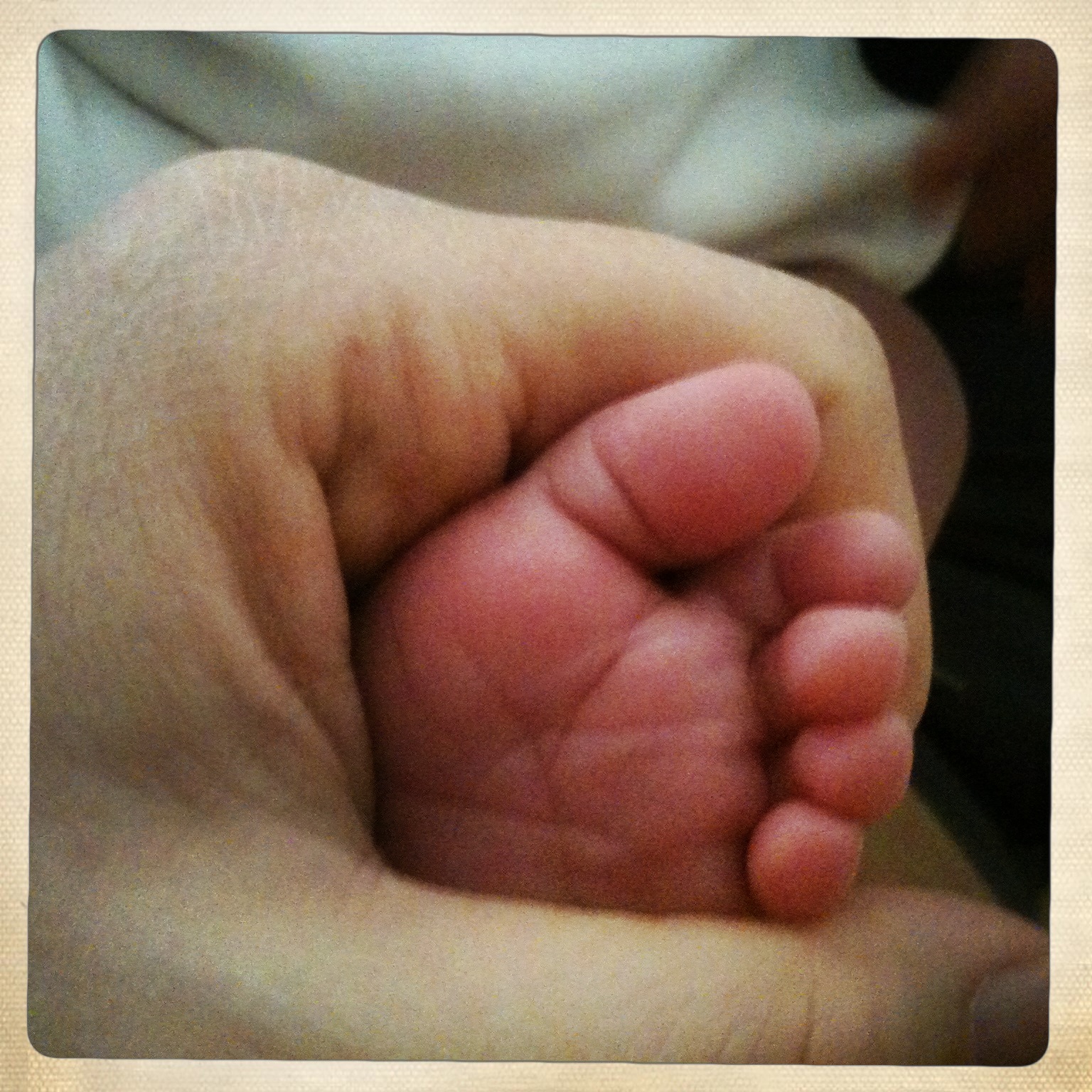
I had seen the documentary The Business of Being Born when it first came out, meaning long before I had even given much thought to the idea of having children. In it Ricki Lake and Abby Epstein take a critical look at the highly medicalized state of childbirth in the US and take some time exploring the movement that defends gentler and more natural forms of bringing babies into the world, including bringing back the work of midwives and home births.
The film made its mark on me even back then, and I’d made a “note to self” to heed its message when the time came. Fast forward to three years ago to my first pregnancy, and I made sure to watch it again with my partner to make sure we would be on the same page.
So this is partly how I found myself asking the kinds of questions to make me feel the most at ease when the big day came, ie the kind of birth where we would let nature take charge as much as possible and only give the process a medical kick in the butt if absolutely necessary (which in the end did turn out to be necessary for me and my baby). And I figured that sharing what I came to understand about the state of modern childbirth could help other women in a similar situation.
Now before I go any further, one very important disclaimer: if there is one absolutely critical lesson about parenthood, it is that it is a constant lesson in letting go of control. You will be reminded time and again that you need to relinquish certain things because they just won’t go the way you think or hope, no matter what. And perhaps at no other moment will you be better reminded of this than during labor and childbirth.
With that being said, I am a big believer in informed consent. Truly free personal choice exists only insofar as you do your homework and prepare yourself ahead of time as much as possible.
I believe in maximum preparation and then… letting go and trusting your body, your birth team and the universe that all will go well and you will end up on the other side safely and joyfully.
No matter what you were like before becoming a parent, it is true that having children will mean you will have to speak your mind and advocate for your family on a regular basis. This begins already in pregnancy. You may actually have more say in how things are done than you realize, and having done your research will go a long way in giving you the confidence to discuss your wishes with your birth team.
Of course every country and culture are different in how they approach childbirth. It is true that the hyper-medicalized and lawsuit-prone America of The Business of Being Born is quite different than France where the public sector is much more prominent in health care. And the fact that the system is largely state-funded means that unnecessary interventions are less frequent. Another big difference is that here midwives are much more present throughout the whole process. All that being said, however, birth here is still viewed as largely a medical event with most women still giving birth with obstetricians even if they have an uncomplicated pregnancy. Also options like birth centers are few and far between, and home births are straight out discouraged by the system.
After some research of the childbirth landscape it quickly became clear to me that I would go with the Groupe Naissances, a team of midwives, obstetricians and psychologists that respect natural physiological birth while providing all the medical options a woman may end up needing. One of their biggest selling points is the suivi global which means that the same midwife or doctor/midwife team follows you throughout the entire pregnancy and is present at the birth (in the realm of the possible of course!). This ensures that you have one person whom you get to know well and you feel at ease around, and who knows your wishes for the big day.
All of this creates an environment of trust and intimacy, two essential ingredients for a peaceful birth.
While there are some very good public hospitals respectful of the same things in Paris, I knew that nowhere would I have the “luxury” of having this one person at my side at all times. But even if you don’t have this kind of option where you live, don’t despair — you can use this handy guide so that you can come as close to the kind of birth environment that you wish to have even in a hospital setting.
If you do not have any special medical considerations and would like to try for a birth that is as intervention-free as possible here’s a list of seven questions about general practices that you can ask when choosing your maternity hospital.
1) How long do they generally wait before inducing?
Medical induction is when labor is provoked or intensified via the use of the artificial form of the hormone oxytocin (the drug called Pitocin in the US).
The fact that the oxytocin is not naturally produced by the body means that the brain is not able to react by releasing the endorphins which would serve as a woman’s coping mechanism. This causes the resulting contractions to be much more intense than what a woman would normally experience, and the intervention also means that the woman is attached to an IV and has to be monitored constantly, largely limiting her movements. All this makes it so that the “cascade of interventions” that may follow (epidural, forceps or vacuum delivery, or even a C-section) becomes more likely.
The most likely reason that will be cited to induce a woman is that the pregnancy is going on for too long. But get this, a “normal” term for a baby can vary by five whole weeks, anywhere from 37 to 42 weeks since the woman’s last period (by the way, this method of calculating a due date leaves so much to be desired! More on that here). So by this measure, it is perhaps more appropriate to talk about a due month as opposed to a due date which wrongly leads people to believe that it’s some sort of deadline.
The rise in early inductions in the US (and this is a growing problem in other places too) has led to more babies being born pre-term, prompting a campaign to limit this type of intervention to at least 39 weeks unless absolutely medically necessary.
Here’s a fun fact: did you know that in France the due date calculation is based on 41, and not 40, weeks? So if your doctor starts pressuring you about an induction, just tell him “well if we were in France, you’d leave me alone for a whole other week” and see if that does the trick!
Women have been led to believe that the final weeks of pregnancy are not essential to their baby’s development but the research suggests otherwise. As the same article goes on to state, “with each decreasing week of gestation below 39 to 40 weeks, there is an increased risk of complications like respiratory distress, jaundice, infection, low blood sugar, extra days in the hospital (including time in the neonatal intensive care unit), and even deaths of newborn babies and older infants.”
On the other hand, risks do start slightly inching up when a pregnancy goes beyond 41 weeks (here’s a very thorough overview of all the literature on this issue) and of course there are cases when inductions are medically warranted, as listed here.
So ask your practitioner how long they wait before inducing as a general rule. And in any case I highly recommend that you do your research in case this question becomes relevant at the end of your pregnancy like it did for me!
2) What is their C-section rate?
Make no mistake about it: Caesareans save lives. Doctors have also gotten much better at the technique in recent years, leading to fewer complications and saving mom, baby or both when medically called for.
But when they become an elective procedure, either upon the doctor or the mother’s request, they start becoming troublesome because that is when the benefits no longer outweigh the risks.
The World Health Organization recommends that the total rate of C-sections in a normal healthy population not exceed 10 to 15%, stating that mortality rates do not improve beyond this rate. However did you know that in countries like Brazil, this rate can go as high as 80% for wealthier segments of society? Or that in my native Turkey most urban well-educated women seem to have been brainwashed to think that having a planned section is somehow preferable to the way nature intended?
The US is also notorious for having medicalized childbirth and marginalized midwife care to the point of having very high rates for avoidable medical interventions. There the rate for C-sections is more than double or even triple the WHO recommendation at more than 30%.
You see, a C-section is not just a harmless cosmetic intervention with no lasting consequences for mother and baby, far from it in fact. A C-section is major abdominal surgery and will require the time it takes to recover from such an operation, complicating the already heady postpartum period and potentially causing more long-term problems.
Other disadvantages of an unnecessary C-section include:
> Consequences for the baby’s gut microbiome: When the birth canal is avoided, the baby misses out on her first opportunity to be inoculated with mom’s bacteria. As the fascinating recent research on the microbiome indicates, this may have lifelong implications for the immune system and health. For more information, I would highly recommend the film Microbirth.
> Avoidance of the natural labor processes: If a C-section is planned and the woman’s body does not go into labor naturally, this means that the body does not get to release its cocktail of hormones which has a host of benefits for mom and baby. Another danger is that the baby is not yet ready to come out (see question no 1 about delivery dates).
> The risk of preterm delivery: As mentioned above, the baby’s last weeks in the womb is of some considerable importance for her development and preparedness for the outside world. In the final weeks of gestation a baby’s fat stores will be improved, to better face the world post-birth, and a full-term baby will also likely have fewer difficulties with breastfeeding.
> Complications for future pregnancies: Having an unnecessary C-section may require that a woman has to have them in the future. Although VBACs (vaginal birth after Caesarean) can be a perfectly healthy option for many women, certain medical teams may refuse to do it or there may be medical reasons not to.
So I hope I have been able to explain why inquiring about your birth team’s approach to C-sections and their overall rates is important. The answers you get should be a good indication of where their philosophy lies — with the comfort and well-being of the mother and baby, or that of the medical staff.
3) Will they do everything to make you feel “at home” during labor and birth?
Perhaps at no other time in our lives are we reminded as intensely of our animal nature as during childbirth. No matter what kind of preparations you have done beforehand, what novel ways to breathe and visualization techniques you have mastered, when the moment comes it’s just so extremely… primal.
One of the most memorable books I read during my first pregnancy was Le Bébé est un mammifère (The baby is a mammal) by the French obstetrician and natural childbirth advocate Michel Odent, who believes that we can draw great lessons from observing other mammals and their behavior during this most intimate time in life. Even in many traditional human cultures, women have sought out things like darkness, complete confidence and privacy, and freedom of movement to birth their babies…
For labor and childbirth to go as smoothly as possible a woman needs to be able to let go of all conscious activity and tap into the animal part of her brain. Getting into this kind of “zone” can be tricky in a brightly lit clinical hospital setting but you may be able to get creative with it. For example turning off some bright lights or turning a lamp towards the wall to create something that resembles “mood lighting” may be doable. And of course if it’s during the day, hopefully you can just have natural lighting in the room.
Having the possibility to move freely is also of utmost importance and partly why needless medical interventions are so detrimental to a natural labor process since they tend to require that a woman be attached to a bed. Remember, the more cozy, comfortable and at home you feel, the more you can relax, let go and let your body do its thing.
Whoever your birth partner is, they can make sure that your comfort and trust are the priority at all times, barring of course any medical necessity.
4) Once the baby is born, how long do they wait before clamping the umbilical cord?
Here’s one of those practices that fell out of favor with the advent of modern hospital birthing practices.
We all know the scene from the movies – the woman gives birth, and the proud father gets to cut the umbilical cord before the baby is whisked off to get washed and clothed. Now there is more than one thing wrong with this picture but let’s start with this: did you know that if the cord is not clamped right away but instead left to stop pulsing on its own (up to five minutes), the baby has a higher chance of getting enough iron stores for at least the first four months of life? Isn’t that just the coolest thing you’ve ever heard?
A practice that costs literally nothing, if only a few of baby’s first minutes of life, can have measurable health outcomes for at least months, if not years down the line.
The WHO now recommends that the birth team wait one to three minutes before clamping the cord (excepting any medical emergencies where baby has to be taken away immediately). So ask about this ahead of time and have your birth partner make sure it happens since you will be in no state to worry about anything else at that point than finally having your bundle of joy in your arms!
5) Do they emphasize skin-to-skin contact and place the baby directly on the mother upon birth? And in the case of a C-section, will they do this with dad (and in some cases even with the mom)?
The benefits of placing the newborn immediately on mom are quite impressive in helping the baby adjust to life outside the womb.
If you imagine for a minute his point of view: after leaving his home for the past 9 months that was warm, dark, comforting and with constant access to food, he is now trying to adjust to this strange, bright and cold world outside.
Your smell is his number one point of reference, the one thing that brings the whole journey together, and being on top of you also helps him regulate his temperature. So it’s important that he stay as close to you as possible in the minutes, hours (and not to mention the days) following his arrival. This is also why having only natural or dimmed light in the room is important so as not to jar the senses of your little newcomer.
This first contact is also extremely important in getting the breastfeeding relationship started. After my son was born, I was amazed at how this little creature, still virtually blind by any standard, ended up inching his way up my torso and found the nipple. It really is a remarkable feat of nature, and perhaps at no other moment in life do you feel, well, so mammalian.
6) Can they hold off on bathing the baby according to your wishes?
Back to that birth scene from the movies, barely did we see the mother scream in agony and relief that a freshly-bathed cute little baby is placed in her arms, fully clothed.
Here’s what’s wrong with this picture: in the womb, the baby’s body is covered with vernix, a waxy, cream-like substance that protects the skin of the fetus from the liquid inside the womb. It has even been found to have similar antimicrobial properties to breast milk. It is important in the postpartum period to let the baby’s skin absorb this naturally.
So when the baby first comes out, it’s sufficient for the staff to just wipe him down as necessary but to leave the rest alone. We waited two days before bathing our baby and you could certainly wait longer too. Holding off on that first bath and keeping the baby close to the mother also mean that he will not have unnecessary trouble keeping warm.
Keeping the vernix for as long as possible to take advantage of its protective powers is especially important for premature babies whose skin barrier and function may not be as robust as a full-term baby’s yet.
7) How do they fare regarding breastfeeding support in the postpartum period?
Here’s one thing first-time mothers have a hard time wrapping their head around: the first days with baby! During the pregnancy you can get so concentrated on the labor and childbirth that the idea of an actual live baby in your arms may seem very abstract, causing you to not even give a single thought to what comes right afterwards (does it sound like I’m speaking from experience?). But believe you me, this part is important!
After giving birth to my son, I actually had lots of problems getting breastfeeding established even though I had read the books, done the classes and was 100% motivated. The often contradictory advice I got from caregivers after the birth did not help either. If your maternity ward does not have a good reputation for breastfeeding support, you may consider hiring a good lactation consultant and seeing them even before the birth so that you have one person who will respond to your unique situation when you’re in need of help. Because one thing is for sure, when you have questions during this period, you need resolution quickly to avoid getting overwhelmed.
So this wraps up my list of questions to consider if you’re interested in improving your birth experience. What I’ve said before bears repeating though: having such a “birth plan” should not hinder you from trusting and letting go when the time comes. I can guarantee you things will not go according to plan but having done your homework will go a long way in making sure this most precious of life’s moments goes in the most respectful and trustful way that it deserves.
What do you think about this list for having a more peaceful birth? Do you have anything to add? Is there anything you wish you’d done differently or that went particularly well? Let me know in the comments below!






Great article. I’m still years away from giving birth having kids but it is nice to be prepared.
Glad you enjoyed! As you can see, I also started getting interested in the subject way before I had babies on my mind. I guess you can never be too prepared!
These are great tips. I completely agree with you that you need to be your own best advocate and your family’s too. My second pregnancy was a high-risk twin pregnancy, so many of these were not even options for safety reasons. I did a lot of research and continue to do so to help other twin mothers.
Shann, it’s so important to know when you need to advocate for yourself and when you need to let go which in your case was a medical necessity. I think you were wise to know the difference!
This is also so true. After my first two births 18 and 15 years ago were not what I wanted and far from peaceful, I educated myself. My next 4 births, 2 birth center, and even the final two induced in a hospital, were EXACTLY what I wanted. Midwife attended, hot tub, natural, peaceful, dark room, etc. Every mother should get what she wants as much as humanly and safely possible. These are GREAT questions to ask to get started. Thanks for sharing.
Wow, mama to six — that’s impressive! Isn’t it amazing what a little knowledge can do to empower women? I’m so happy to hear your subsequent births were on your own terms.